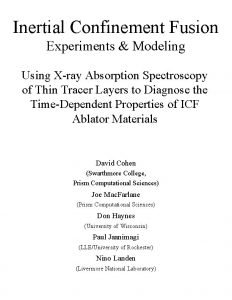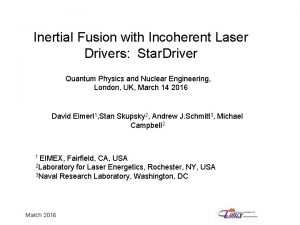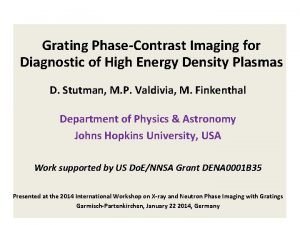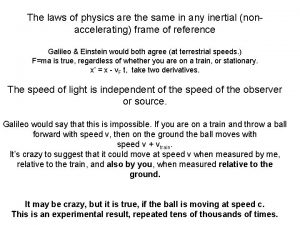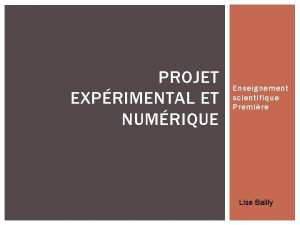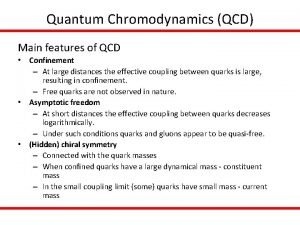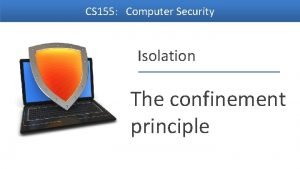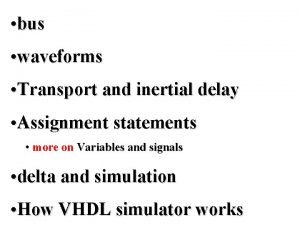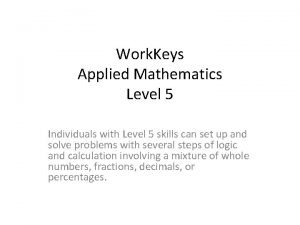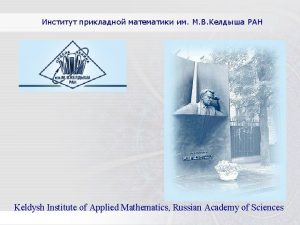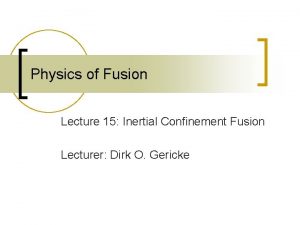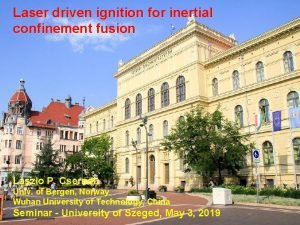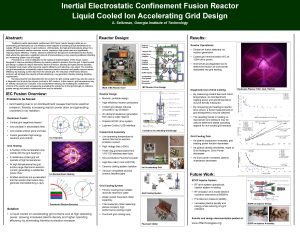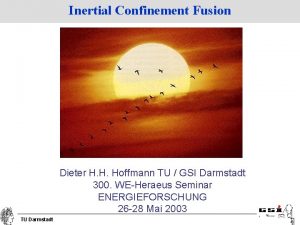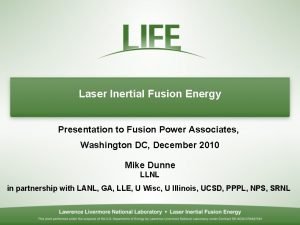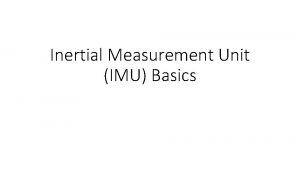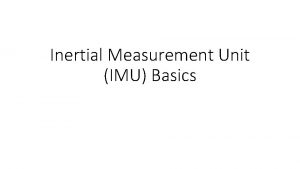Inertial Confinement Fusion and Applied Mathematics David Starinshak













- Slides: 13

Inertial Confinement Fusion and Applied Mathematics David Starinshak Ph. D Student, Applied Mathematics University of Michigan Department of Mathematics Advisor: Brian Spears Lawrence Livermore National Laboratory

Outline Background – National Ignition Facility – Inertial Confinement Fusion (ICF) My Project in a Nutshell – Problem Statement – Geometric Interpretation Other Projects Relevant to AIM

National Ignition Facility Multi-billion dollar program by Department of Energy to achieve world’s first fusion reaction

National Ignition Facility

Inertial Confinement Fusion • Millimeter-sized capsule of frozen deuterium and tritium (DT) • X-ray energy compresses capsule by factor of 30 • Temperatures exceed 10, 000 Kelvin • Pressure reaches 1 billion atmospheres • DT fuses into helium, releasing ~18 MJ of energy • All happens in < 20 nanoseconds

Problem Statement X-ray Image Features Experimental Parameters Target radius - Laser power Peak width - Capsule roughness - Doping concentration … … Contour RMS {velocity, mass} Nuclear Features Quantities like implosion velocity, mass, entropy, and temperature can characterize a successful experiment HOWEVER Such quantities cannot be measured directly from observations 1. Can we understand the state of an experiment from observations? 2. Which observations are most informative in making a distinction?

Problem Statement X-ray Image Features Experimental Parameters Target radius - Laser power Peak width - Capsule roughness - Doping concentration … … Contour RMS {velocity, mass} Nuclear Features Scaled Problem 3 parameters instead of 200+ – Capsule thickness – Ablator density – Ablator opacity

Problem Statement X-ray Image Features Experimental Parameters Target radius - Laser power Peak width - Capsule roughness - Doping concentration … … Contour RMS {velocity, mass} Nuclear Features Scaled Problem 1 D simulations – Unclassified hydrodynamic code HYDRA – Simulates laser-driven implosion and (possible) nuclear burn – 4000+ runs

Problem Statement X-ray Image Features Experimental Parameters Target radius - Laser power Peak width - Capsule roughness - Doping concentration … … Contour RMS {velocity, mass} Scaled Problem Yorick Postprocessing – Images simulated using Abel Transform – Images processed into discrete set of features – Nuclear features calculated Nuclear Features

Geometric Interpretation Important Questions • Do different classifications cluster in the space of observations? • Can classifications be separated in feature space? • How many features are needed? • Which are the most informative?

Image Processing Problems • Extracting information from noisy X-ray radiograms • Implementing fast variational methods to filter, de-noise, and detect edges • Reconstruct 3 D picture of imploding capsule from multiple, time-resolved 2 D images

Fluid Dynamics Problems • Numerical approximations for extreme plasma dynamics • Theoretical and applied analysis of turbulent mixing • Fluid interface instability problems (Rayleigh-Taylor and Kelvin-Helmholtz) • Nonlinear analysis of dynamic instabilities

Theoretical and Applied CS • Machine learning algorithms – Data mining and Bayesian analysis – Feature selection and feature engineering • Efficient numerical methods for non-conservation problems – diffusion, convection, neutron transport, etc Training Data BT < 18. 4 ns 18. 4 < BT < 18. 8 BT > 18. 8 ns Im_max < 4 Min_var = 0 Min_var ≠ 0 4 < Im_max < 6 6 < Im_max < 8 Min_var = 0 Min_var ≠ 0 Im_max > 8
 Inertia xray
Inertia xray Inertial confinement
Inertial confinement Inertial confinement
Inertial confinement Inertial frame of reference
Inertial frame of reference Inertial and non inertial frame of reference
Inertial and non inertial frame of reference Thomas silverstein
Thomas silverstein Projet enseignement scientifique son
Projet enseignement scientifique son Confinement qcd
Confinement qcd Confinement principle in computer system security
Confinement principle in computer system security Solitary confinement effects
Solitary confinement effects Assignment statement
Assignment statement Workkeys applied mathematics level 5 answers
Workkeys applied mathematics level 5 answers Keldysh institute of applied mathematics
Keldysh institute of applied mathematics Wearable inertial sensors
Wearable inertial sensors
